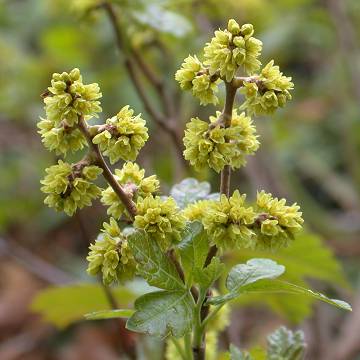

Rhus aromatica - (image 1 of 7)
Taxonomy
Family: Anacardiaceae
Habitat
Rocky slopes and bluffs. The var. arenaria occurs on foredunes facing Lake Michigan, low dune ridges, and sandy oak savanna.
Associates
Distribution
Most of the eastern half of the U.S. and adjacent Canada.
Morphology
Branching shrub to 2 m. Leaves trifoliate; leaflets sessile or nearly so, cleft or toothed above the middle. Flowers pale yellow, in spike-like, axillary clusters formed on growth from the previous season. Fruits red, hairy.
Notes
Flowers early May to early June
Wetland indicator: Upland
Most of the plants pictured here is the cultivar 'Gro-low', a popular ground cover. The specific epithet "aromatica" refers to the unpleasant smell of this plant when bruised or broken.
The last image is of R. aromatica var. arenaria (Greene) Fernald, a low, almost prostrate shrub with smaller leaflets that are densely pubescent below, and flowers that emerge well after the leaves unfold. It occurs on dunes along the southern edge of the Great Lakes. It was photographed at Indiana Dunes State Park.
References
Gleason, Henry A. and A. Cronquist. 1991. Manual of Vascular Plants of Northeastern United States and Adjacent Canada. Second Ed.
The New York Botanical Garden. Bronx, NY
Swink, F. and G. Wilhelm. 1994. Plants of the Chicago Region.
Indiana Academy of Science. The Morton Arboretum. Lisle, Illinois.
USDA, NRCS. 2002.
The PLANTS Database, Version 3.5 (http://plants.usda.gov).
National Plant Data Center, Baton Rouge, LA 70874-4490 USA.
|
Michael Hough © 2005 |